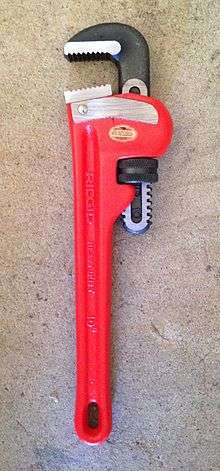Pipe wrench
 A modern pipe wrench. | |
| Classification | hand tool |
|---|---|
| Related | wrench, plumber wrench, monkey wrench |
The pipe wrench (US), Stillson wrench or Stillsons (UK) is an adjustable wrench used for turning soft iron pipes and fittings with a rounded surface. The design of the adjustable jaw allows it to lock in the frame, such that any forward pressure on the handle tends to pull the jaws tighter together. Teeth angled in the direction of turn dig into the soft pipe. They are not intended for use on hardened steel hex nuts or other fittings because they would ruin the head; however, if a hex nut is soft enough that it becomes rounded beyond use with standard wrenches, a pipe wrench is sometimes used to break the bolt or nut free. Pipe wrenches are usually sold in the following sizes (by length of handle): 10, 12, 14, 18, 24, 36, and 48 inches, although smaller and larger sizes are available as well. They are usually made of cast steel. Today, aluminum is also used to construct the body of the wrench, while the teeth and jaw remain steel. Teeth, and jaw kits (which also contain adjustment rings and springs) can be bought to repair broken wrenches, as this is cheaper than buying a new wrench.
History

The first pipe, or stillson, wrench was created by Daniel C. Stillson (1826-1899) while working as a mechanic at the Walworth Company, in Cambridge, Massachusetts.[1] On October 12, 1869, U.S. patent #95,744 was issued to Stillson.[2]
In Prince Edward Island, Canada there is some controversy over the true creator of the wrench. In the island folklore, the wrench was developed by Owen "Iney" McCluskey, although no proof has ever been presented that would suggest that McCluskey and Stillson ever met.
On 17 August 1888 the Swedish inventor Johan Petter Johansson (1853-1943) took his first patent on the adjustable pipe wrench.[3] The Swedish Patent Office issued the patent (SE 5636) again in 1894. The idea emerged after he established his company Enköpings Mekaniska Verkstad. Back then there was no standard on nut dimensions so each time a trades man was out on a job, he needed a trolley to take a whole set of fixed pipe wrenches with him. Johan Petter Johansson invented a tool that could grip different nuts dimensions.[4]
Pipe wrench in different countries
In South Africa, the terms "bobbejaan spanner" and "baboon spanner" are commonly used,[5] especially for large pipe wrenches. "Bobbejaan" is the Afrikaans term for a baboon. In Zimbabwe it was usually known by an Anglicized version of the Afrikaans name, "bobbiejohn spanner".
In the United Kingdom these wrenches are often described by their size, i.e. 18" wrenches are known as "18s", or by the general name of "Stillies/stills".
These spanners are sometimes called "footprints" in Australia.
See also
- Adjustable spanner
- Nipple wrench, a pipe wrench that grabs the interior
- Plumber wrench
References
- ↑ The great workshop: Boston's Victorian Age. Arcadia Publishing.
- ↑ "IMPROVEMENT IN WRENCH". United States Patent and Trademark Office.
- ↑ Bahco
- ↑ Svenska uppfinnare, Petter Karlsson and Johan Erséus, 2003, Sweden
- ↑ South African Concise Oxford Dictionary 2002 p124
External links
- Biography of Daniel C. Stillson and background on the development of the Stillson wrench.
- Adjustable wrenches review